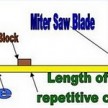Table Saw Blade Height
What is the correct table saw blade height?

New safety thoughts:
The other, competing view is that the saw functions at its best when set high above the wood being cut. When the angle of the blade teeth arc relative to the top surface of the workpiece, facilitating chip removal and shortening the overall distance through which the teeth cut through the wood.
Proponents of the higher blade height believe that a low blade height will increase heat buildup and drag on the motor. We all know that heat is bad for the blade, and drag on the motor makes it work harder, all of this increases the likely hood of the wood kicking back at the user.
My Opinion:
Everybody wants to know the correct blade height, but there really isn’t any. Different cuts operations often require different saw blade heights.
Test it for yourself. The cleanest and most efficient cuts occur with the blade raised to its maximum height but not many people, myself included are willing to trade this for safety. Too high a height increases the risk of a body part contacting the blade.
A reasonable compromise is probably somewhere in between the two schools of thought. A saw blade height of 1″ to 1.5″ showing above the wood being cut is a nice compromise.
What height do you use?

If you enjoyed this post, make sure you subscribe to my RSS feed or receive updates via email











